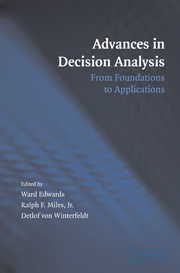Book contents
- Frontmatter
- Contents
- List of Contributors
- Preface
- 1 Introduction
- PART I HISTORY AND FOUNDATIONS OF DECISION ANALYSIS
- PART II STRUCTURING DECISION PROBLEMS
- PART III PROBABILITIES AND BAYES NETS
- PART IV UTILITIES
- PART V RISK ANALYSIS
- 15 Probabilistic Risk Analysis for Engineered Systems
- 16 The Engineering Risk-Analysis Method and Some Applications
- 17 Health Risk Analysis for Risk-Management Decision-Making
- PART VI DECISION ANALYSIS IN A BEHAVIORAL AND ORGANIZATIONAL CONTEXT
- PART VII APPLICATIONS OF DECISION ANALYSIS
- Index
- References
17 - Health Risk Analysis for Risk-Management Decision-Making
Published online by Cambridge University Press: 05 June 2012
- Frontmatter
- Contents
- List of Contributors
- Preface
- 1 Introduction
- PART I HISTORY AND FOUNDATIONS OF DECISION ANALYSIS
- PART II STRUCTURING DECISION PROBLEMS
- PART III PROBABILITIES AND BAYES NETS
- PART IV UTILITIES
- PART V RISK ANALYSIS
- 15 Probabilistic Risk Analysis for Engineered Systems
- 16 The Engineering Risk-Analysis Method and Some Applications
- 17 Health Risk Analysis for Risk-Management Decision-Making
- PART VI DECISION ANALYSIS IN A BEHAVIORAL AND ORGANIZATIONAL CONTEXT
- PART VII APPLICATIONS OF DECISION ANALYSIS
- Index
- References
Summary
ABSTRACT. Health risk assessment offers a framework for applying scientific knowledge and data to improve “rational” (consequence-driven) risk-management decision making when the consequences of alternative decisions are uncertain. It does so by clarifying both: (a) The probable consequences of alternative decisions (usually represented by conditional probabilities of different consequences occurring, given specified current information and probabilistic risk models); and (b) How current uncertainties about probable consequences might change as more information is gathered. This chapter summarizes methods, principles, and high-level procedures for using scientific data (e.g., biological and epidemiological knowledge) (1) to assess and compare the probable human health consequences of different exposures to hazards (i.e., sources of risk); (2) to predict likely changes in exposures and risks caused by alternative risk-management interventions; and (3) to evaluate and choose among interventions based on their probable health consequences. The usual goal of these methods is to identify and select actions or interventions that will cause relatively desirable probability distributions of human health consequences in affected populations. We discuss the steps of hazard identification (including causal analysis of data), exposure assessment, causal dose-response modeling, and risk and uncertainty characterization for improving health risk-management decision making.
Public health risk analysis deals with decisions about which of a set of available risk-management interventions (usually including the status quo or “do-nothing” option) should be implemented. For example, should cell phone use in cars be banned? Under what conditions, if any, should cattle be imported from countries with low levels of diseases such as BSE?
- Type
- Chapter
- Information
- Advances in Decision AnalysisFrom Foundations to Applications, pp. 325 - 350Publisher: Cambridge University PressPrint publication year: 2007
References
- 2
- Cited by



